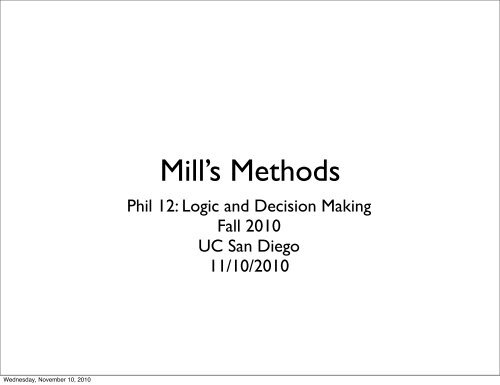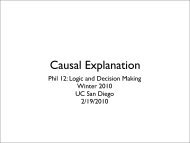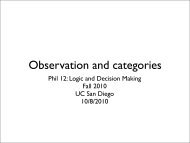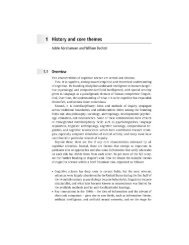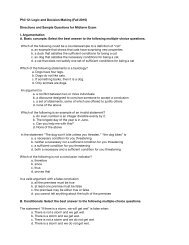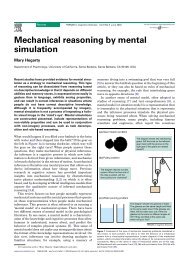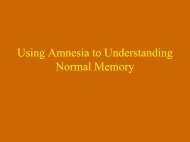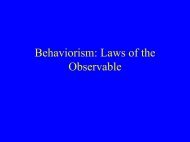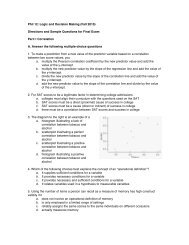Causal reasoning: Mill's methods - UC San Diego
Causal reasoning: Mill's methods - UC San Diego
Causal reasoning: Mill's methods - UC San Diego
You also want an ePaper? Increase the reach of your titles
YUMPU automatically turns print PDFs into web optimized ePapers that Google loves.
Wednesday, November 10, 2010<br />
Mill’s Methods<br />
Phil 12: Logic and Decision Making<br />
Fall 2010<br />
<strong>UC</strong> <strong>San</strong> <strong>Diego</strong><br />
11/10/2010
Review<br />
• Distinguish necessary and sufficient causes<br />
• Most causes are neither necessary nor<br />
sufficient<br />
- Rather, contributory/partial<br />
• Distinguish proximate and ultimate causes<br />
Wednesday, November 10, 2010
Plentiful rainfall is:<br />
Wednesday, November 10, 2010<br />
Clicker question 1<br />
A. A sufficient cause of wildflowers blooming<br />
B. A contributory cause of wildflowers blooming<br />
C. Not a cause of blooming because it is not<br />
sufficient to cause blooming<br />
D. Too ultimate to count as a cause of wildflowers<br />
blooming
John Stuart Mill<br />
• Methods for selecting actual causes among<br />
possible causes (before the development of<br />
statistics!)<br />
Wednesday, November 10, 2010<br />
- Start with variables assumed to include the possible<br />
causes<br />
- Use correlation to separate actual causes from possible<br />
causes<br />
• Mill did not have modern statistics available, so he used<br />
simple, eye-ball correlations<br />
- Failure of a putative cause to correlate with the effect in<br />
the right way indicates lack of causation<br />
• Or better, our inability to find the cause!
Method of agreement<br />
• “If two or more instances of the phenomenon<br />
under investigation have only one circumstance<br />
in common, the circumstance in which alone all<br />
the instances agree, is the cause (or effect) of<br />
the given phenomenon.”<br />
• Find cases in which the effect has occurred<br />
- Determine if there is only one thing that they<br />
all share<br />
Wednesday, November 10, 2010<br />
- If there is, that is (the likely) cause
C<br />
Wednesday, November 10, 2010<br />
A B<br />
Method of agreement<br />
D<br />
E<br />
G<br />
H<br />
C<br />
K<br />
E
Method of agreement<br />
• Example: some cities have markedly lower rates<br />
of tooth decay<br />
Wednesday, November 10, 2010<br />
- Is there anything these cities share in<br />
common?<br />
• If so, that is the likely cause of lower rates<br />
of tooth decay
Table for Method of Agreement<br />
Dental<br />
Education<br />
Program<br />
Free<br />
Dental<br />
Clinics<br />
Fluoride<br />
in Water<br />
High<br />
salaries<br />
for<br />
dentists<br />
Low rates<br />
of tooth<br />
decay<br />
Dullsville Yes No Yes No Yes<br />
Bedroom<br />
Town<br />
No Yes Yes Yes Yes<br />
Golfville No No Yes No Yes<br />
Megacity Yes Yes Yes No Yes<br />
Wednesday, November 10, 2010
Table for Method of Agreement<br />
Dental<br />
Education<br />
Program<br />
Free<br />
Dental<br />
Clinics<br />
Fluoride<br />
in Water<br />
High<br />
salaries<br />
for<br />
dentists<br />
Low rates<br />
of tooth<br />
decay<br />
Dullsville Yes No Yes No Yes<br />
Bedroom<br />
Town<br />
No Yes Yes Yes Yes<br />
Golfville No No Yes No Yes<br />
Megacity Yes Yes Yes No Yes<br />
Wednesday, November 10, 2010
Method of Agreement at Work<br />
•<br />
- Patient 1: damage to the prefrontal cortex and the<br />
- Patient 2: damage to the hippocampus, amygdala, and<br />
- Patient 3: damage to the thalamus and hippocampus<br />
- Patient 4: damage to the prefrontal cortex,<br />
- Patient 5: damage to the hippocampus and amygdala<br />
Wednesday, November 10, 2010<br />
Five patients all show amnesia after brain injury:<br />
hippocampus<br />
entorhinal cortex<br />
hypothalamus, hippocampus, and amygdala
Method of difference<br />
• “If an instance in which the phenomena under<br />
investigation occurs and an instance in which it<br />
Wednesday, November 10, 2010<br />
does not occur, have every circumstance in<br />
common save one, that one occurring only in<br />
the former, the circumstance in which alone the<br />
two instances differ, is the effect, or the cause,<br />
or an indispensable part of the cause, of the<br />
phenomenon.”
Method of difference - 2<br />
• Find two things that differ in that one has the<br />
effect and the other doesn’t<br />
C<br />
Wednesday, November 10, 2010<br />
- If there is only one factor on which they<br />
differ, that is the likely cause<br />
A B<br />
D<br />
E<br />
D<br />
A<br />
B<br />
EX
Method of Difference - 3<br />
• Example: four people apply for a loan, and only<br />
two get are approved for a loan<br />
Wednesday, November 10, 2010<br />
- Is there anything that differs between the<br />
people who got the loan and the people who<br />
didn’t?<br />
• If so, that’s the likely cause of their not<br />
getting the loan
Table of Method of Difference<br />
College<br />
Education<br />
Earn over<br />
$80K<br />
Own<br />
Business<br />
Declared<br />
Bankruptcy<br />
Loan<br />
Approved<br />
Victor Yes Yes No Yes No<br />
Crystal Yes Yes No No Yes<br />
Tad Yes Yes No No Yes<br />
Chin Yes Yes No Yes No<br />
Wednesday, November 10, 2010
Table of Method of Difference<br />
College<br />
Education<br />
Earn over<br />
$80K<br />
Own<br />
Business<br />
Declared<br />
Bankruptcy<br />
Loan<br />
Approved<br />
Victor Yes Yes No Yes No<br />
Crystal Yes Yes No No Yes<br />
Tad Yes Yes No No Yes<br />
Chin Yes Yes No Yes No<br />
Wednesday, November 10, 2010
•<br />
•<br />
Example of Yellow Fever<br />
Once Walter Reed suspected mosquitoes as<br />
the transmitter of yellow fever<br />
- He had one set of volunteers sleep on the<br />
soiled clothes and beds of yellow fever<br />
patients in a room screened so that no<br />
mosquitoes could get in.<br />
• None of these people contracted the<br />
disease.<br />
He had another group of volunteers stay<br />
completely away from sick patients, except<br />
he let mosquitoes that had been allowed to<br />
feast first on people sick with the disease<br />
bite the patients.<br />
- These volunteers did get sick.<br />
Wednesday, November 10, 2010
Joint method of agreement and difference<br />
• The <strong>methods</strong> of agreement and difference can be used<br />
jointly:<br />
- Find something in common amongst all cases where the<br />
effect appears<br />
- Find matches for all these cases except that they lack the<br />
effect and the common ingredient<br />
• Example: Five factory workers are found to be inefficient<br />
relative to others who are doing the same work.<br />
Wednesday, November 10, 2010<br />
- The efficient workers and the inefficient workers were<br />
found to be similar in all relevant ways except one: the<br />
inefficient workers were not part of a profit sharing plan.<br />
- Conclusion: profit sharing causes efficiency.
Method of concomitant variation<br />
• “Whatever phenomenon varies in any manner whenever<br />
another phenomenon varies in some particular manner<br />
is either a cause or an effect of that phenomenon or is<br />
connected with it through some fact of causation.”<br />
Wednesday, November 10, 2010<br />
Amount<br />
of Water<br />
Amount<br />
of<br />
Fertilizer<br />
Amount<br />
of<br />
Sunlight<br />
Crop<br />
Yield<br />
Plot A 13 2 51 8<br />
Plot B 14 3 45 12<br />
Plot C 12 4 46 16
Method of concomitant variation<br />
• “Whatever phenomenon varies in any manner whenever<br />
another phenomenon varies in some particular manner<br />
is either a cause or an effect of that phenomenon or is<br />
connected with it through some fact of causation.”<br />
Wednesday, November 10, 2010<br />
Amount<br />
of Water<br />
Amount<br />
of<br />
Fertilizer<br />
Amount<br />
of<br />
Sunlight<br />
Crop<br />
Yield<br />
Plot A 13 2 51 8<br />
Plot B 14 3 45 12<br />
Plot C 12 4 46 16
Method of residues<br />
• “Subduct from any phenomenon such part as is<br />
known by previous inductions to be the effect<br />
Wednesday, November 10, 2010<br />
of certain antecedents, and the residue of the<br />
phenomenon is the effect of the remaining<br />
antecedents.”<br />
C2<br />
C1<br />
C1<br />
E1<br />
E1<br />
E2
Method of residues - 2<br />
• Distinguish three features of a plant's growth pattern:<br />
- The development of large, healthy green leaves<br />
- The development of strong stems and root structure<br />
- The production of fruit and flowers<br />
• Applying a 10-10-10 fertilizer (nitrogen-phosphorus-potassium) results<br />
in all three.<br />
- What causes what? We know that:<br />
• Nitrogen promotes the healthy growth of leaves<br />
• Potassium encourages the development of stronger stems and<br />
roots<br />
• In addition to these, our fertilized plants also produce fruit and flowers<br />
more prolifically than usual.<br />
- Since we know what caused the improved growth of leaves, stems,<br />
and roots<br />
• we infer that the "residue", the increase in the number of fruit<br />
and flowers, was caused by the phosphorus<br />
Wednesday, November 10, 2010
•<br />
•<br />
- But beware, this can sometimes backfire:<br />
Wednesday, November 10, 2010<br />
What is Mill saying?<br />
Once you have identified the plausible candidate causes:<br />
Correlation (of a simple matching sort) can isolate the<br />
actual (or at least a good candidate) cause<br />
Assumption behind Mill’s <strong>methods</strong>: one and only one factor is<br />
the cause, and it is one you have considered<br />
• A man “drank rye and water on the first night and<br />
became drunk. On the second night, he drank scotch<br />
and water and became drunk again. On the third night,<br />
he got drunk on bourbon and water. He therefore<br />
decided that the water was the cause of his getting<br />
drunk because it was the common element each<br />
time.” (Christiansen, 1994, p. 76)
Mill’s Methods: Probative, but not Definitive<br />
• As the alcohol and water example shows, Mill’s <strong>methods</strong> do<br />
not always correctly identify the cause<br />
- The true cause might go unnoticed<br />
- Something might correlate with the effect but not be the<br />
cause<br />
- The causal structure might be complex, involving<br />
interactions of multiple factors<br />
• Nonetheless, Mill’s <strong>methods</strong> are useful in clarifying our<br />
understanding of cause and how we test for it<br />
• The development of modern statistics came after Mill and<br />
provided a much more potent tool for identifying the<br />
factors Mill was seeking to identify<br />
Wednesday, November 10, 2010
Which of Mill’s <strong>methods</strong> is illustrated in this example:<br />
Wednesday, November 10, 2010<br />
Clicker question 3<br />
You call Tom and Ray because your car makes a funny<br />
noise. They inquire and learn that you always drive with<br />
your pet bird in the back seat. They ask you to leave the<br />
bird at home while you drive and you find there is no<br />
noise. You conclude the bird is the cause of the funny<br />
noise.<br />
A. Method of agreement<br />
B. Method of difference<br />
C. Method of residues<br />
D. Method of concomitant variation
Which of Mill’s <strong>methods</strong> is illustrated in this example:<br />
In the past when you have gone to the beach, you have<br />
gotten a sun burn. Also, when you have smoked cigarettes<br />
you have developed a headache. Today you went to the<br />
beach, smoked, and ate shrimp, and got sun burned,<br />
developed a headache, and had a bad stomach ache. You<br />
conclude that eating shrimp is the cause of your stomach<br />
ache.<br />
Wednesday, November 10, 2010<br />
Clicker question 4<br />
A. Method of agreement<br />
B. Method of difference<br />
C. Method of residues<br />
D. Method of concomitant variation
Which of Mill’s <strong>methods</strong> is illustrated in this example:<br />
Wednesday, November 10, 2010<br />
Clicker question 5<br />
In January 1997, 2001, and 2004 <strong>San</strong> <strong>Diego</strong> had unusually<br />
high rainfall. Each of those years there was a strong El<br />
Niño. You conclude that El Niño causes lots of rain.<br />
A. Method of agreement<br />
B. Method of difference<br />
C. Method of residues<br />
D. Method of concomitant variation
Given the following data, which of Mill’s <strong>methods</strong> can be used to draw a<br />
conclusion about causal influences on Phil 12 grades?<br />
Wednesday, November 10, 2010<br />
Clicker question 6<br />
Hours spent<br />
studying<br />
Overall GPA<br />
A. Method of agreement<br />
B. Method of difference<br />
C. Method of residues<br />
D. Method of concomitant variation<br />
Grade in Phil<br />
12<br />
Student 1 4 3.1 70%<br />
Student 2 7 2.5 80%<br />
Student 3 11 3.9 90%


